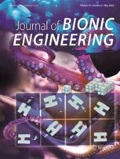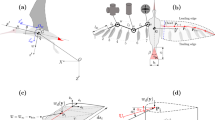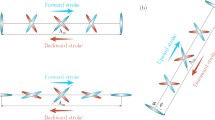Abstract
Flap-bounding, a form of intermittent flight, is often exhibited by small birds over their entire range of flight speeds. Its purpose is unclear during low to medium speed (2 m·s−1–8 m·s−1) flight: aerodynamic models suggest continuous flapping would require less power output and lower cost of transport. To explore its functional significance at low speeds, we measured body trajectory and kinematics of wings and tail of two zebra finches (Taeniopygia guttata) during flights between two perches in a laboratory. The flights consisted of three phases: initial, descending and ascending. Zebra finch first accelerated using continuous flapping, then descended, featuring intermittent bounds. The flight was completed by ascending using nearly-continuous flapping. When exiting bounds in descending phase, they achieved higher velocity than that of pre-bound forward by swinging their body forward similar to pendular motion with conserved mechanical energy. We recorded takeoffs of three black-capped chickadees (Poecile atricapillus) in the wild and also found similar kinematics. Our modeling of power output indicated finch achieved higher velocity (13%) with lower cost of transport (9%) when descending, compared with continuous flapping in previously studied pigeons. Flap-bounding could be useful for unmanned aerial vehicle design by mimicking descending flight to achieve rapid take-off and transition to forward flight.
Similar content being viewed by others
References
Rayner J M V. Bounding and undulating flight in birds. Journal of Theoretical Biology, 1985, 117, 47–77.
Tobalske B W. Morphology, velocity, and intermittent flight in birds. American Zoologist, 2001, 41, 177–187.
Tobalske B W. Scaling of muscle composition, wing morphology, and intermittent flight behavior in woodpeckers. Auk, 1996, 113, 151–177.
Csicsáky M J. Body-gliding in the zebra finch. Fortschritte der Zoologie, 1977, 24, 275–286.
Rayner J M V, Viscardi P W, Ward S, Speakman J R. Aerodynamics and energetics of intermittent flight in birds. American Zoologist, 2001, 41, 188–204.
Lighthill M J. Introduction to the scaling of aerial locomotion. In: Scale Effects in Animal Locomotion, Academic Press, New York, USA, 1977, 365–404.
Alexander R McN. Optima for Animals, Arnold, London, UK, 1982.
DeJong M J. Bounding Flight in Birds, Ph.D dissertation, University of Wisconsin, USA, 1983.
Ward-Smith A J. Analysis of the aerodynamic performance of birds during bounding flight. Mathematical Biosciences, 1984, 68, 137–147.
Ward-Smith A J. Aerodynamic and energetic considerations relating to undulating and bounding flight in birds. Journal of Theoretical Biology, 1984, 111, 407–417.
Tobalske B W. Hovering and intermittent flight in birds. Bioinspiration & Biomimetics, 2010, 5, 1–10.
Pennycuick C J. Modelling the Flying Bird, 1st ed., Academic Press, New York, USA, 2008.
Tobalske B W, Peacock W L, Dial K P. Kinematics of flap-bounding flight in the zebra finch over a wide range of speeds. Journal of Experimental Biology, 1999, 202, 1725–1739.
Tobalske B W, Hearn J W D, Warrick D R. Aerodynamics of intermittent bounds in flying birds. Experiments in Fluids, 2009, 46, 963–973.
Sachs G. New modeling approach for bounding flight in birds. Mathematical Biosciences, 2011, 234, 75–83.
Sachs G. Wind effects on bounding flight. Journal of Experimental Biology, 2013, 316, 35–41.
Dial K P, Greene E, Irschick D J. Allometry of behavior. Trends in Ecology & Evolution, 2008, 23, 394–401.
Berg A M, Biewener A A. Wing and body kinematics of takeoff and landing flight in the pigeon (Columba livia). Journal of Experimental Biology, 2010, 213, 1651–1658.
Hedrick T L. Software techniques for two- and three-dimensional kinematic measurements of biological and biomimetic systems. Bioinspiration & Biomimetics, 2008, 3, 34001–34006.
Dunning J B. CRC Handbook of Avian Body Masses, CRC Press, Boca Raton, FL, USA, 1992.
Theriault D H, Fuller N W, Jackson B E, Bluhm E, Evangelista D, Wu Z, Betke M, Hedrick T L. A protocol and calibration method for accurate multi-camera field videography. Journal of Experimental Biology, 2014, 217, 1843–1848.
Bokhorst E V, Kat R D, Elsinga G E, Lentink D. Feather roughness reduces flow separation during low Reynolds number glides of swifts. Journal of Experimental Biology, 2015, 218, 3179–3191.
Rayner J M V. A vortex theory of animal flight. Part 2. The forward flight of birds. Journal of Fluid Mechanics, 1979, 91, 731–763.
Norberg U M. Vertebrate Flight: Mechanics, Physiology, Morphology, Ecology and Evolution (Zoophysiology), 1st ed., Springer, New York, USA, 1990.
Johnson W. Helicopter Theory, Princeton University Press, Princeton, USA, 1980.
Askew G N, Marsh R L, Ellington C P. The mechanical power output of the flight muscles of blue-breasted quail during take-off. Journal of Experimental Biology, 2001, 204, 3601–3619.
Berg A M, Biewener A A. Kinematics and power requirements of ascending and descending flight in the pigeon (Columba livia). Journal of Experimental Biology, 2008, 211, 1120–1130.
Tobalske B W, Hedrick T L, Dial K P, Biewener A A. Comparative power curves in bird flight. Nature, 2003, 421, 363–366.
Su J Y, Ting S C, Chang Y H, Yang J T. A passerine spreads its tail to facilitate a rapid recovery of its body posture during hovering. Journal of the Royal Society Interface, 2012, 9, 1674–1684.
Bélendez A, Pascual C, Méndez D I, Beléndez T, Neipp C. Exact solution for the non-linear pendulum. Revista Brasileira de Ensino de Física, 2007, 29, 645–648.
Garland T, Bennett A F, Rezende E L. Phylogenetic approaches in comparative physiology. Journal of Experimental Biology, 2005, 208, 3015–3035.
Keennon M, Klingebiel K, Won H, Andriukov A. Development of the nano hummingbird: A tailless flapping wing micro air vehicle. Proceedings of the 50th AIAA Aerospace Sciences Meeting, Nashville, USA, 2012.
Powers C, Mellinger D, Kushleyev A, Kothmann B, Kumar V. Influence of aerodynamics and proximity effects in quadrotor flight. Experimental Robotics, 2013, 88, 289–302.
Acknowledgments
All procedures involving the animals were approved by the Institutional Animal Care and Use Committee of University of Montana. We thank Anne Davis for assistance with preliminary research that motivated the present study and Mathew Gutierrez and Gaëlle Lefeuvre for assistance with video recording indoors and outdoors, respectively. Supported by NSF CMMI 1234747.
Author information
Authors and Affiliations
Corresponding author
Electronic supplementary material
Rights and permissions
About this article
Cite this article
Wang, Y., Tobalske, B.W., Cheng, B. et al. Gravitation-enabled Forward Acceleration during Flap-bounding Flight in Birds. J Bionic Eng 15, 505–515 (2018). https://doi.org/10.1007/s42235-018-0041-9
Published:
Issue Date:
DOI: https://doi.org/10.1007/s42235-018-0041-9




